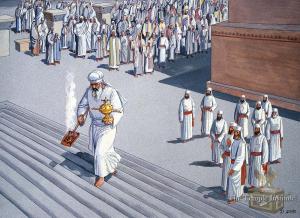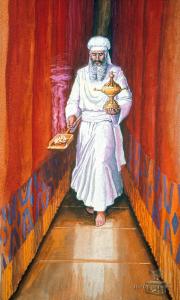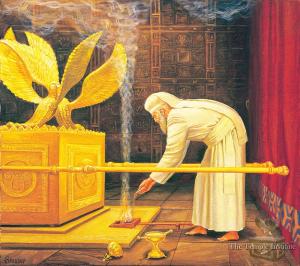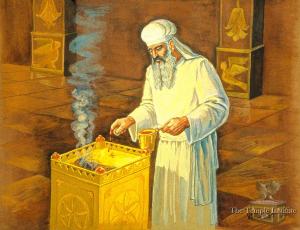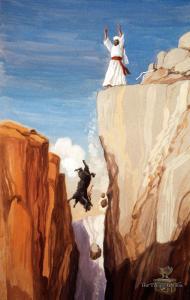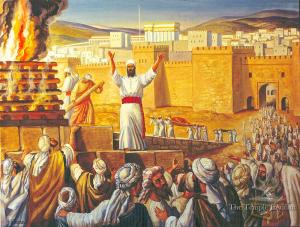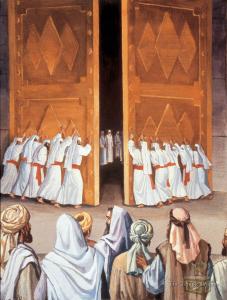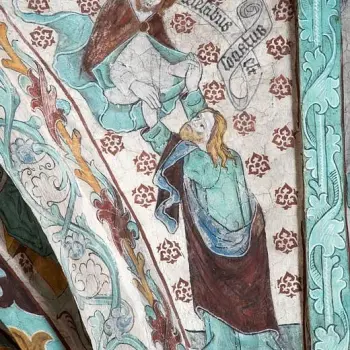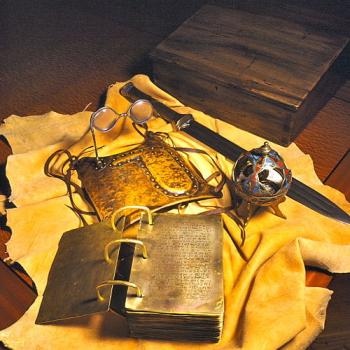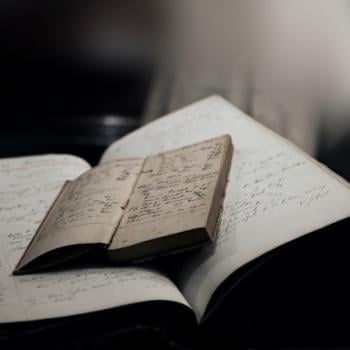Today is Yom Kippur, the Day of Atonement. It is 1o Tishri, the holiest day on the Jewish calendar, the culmination of 10 days of repentance beginning at Rosh Hashanah, the New Year. All temple ceremonies were preparatory to and anticipatory for the Day of Atonement where the High Priest of Israel offered prescribed sacrifices petitioning God to redeem Israel’s sins.
Leviticus 23:27 summarizes Jehovah’s instructions for a Day of Atonement given in Leviticus 16.
Also on the tenth day of this seventh month there shall be a day of atonement: it shall be an holy unto you; and ye shall your souls, and offer an offering made by fire unto the Lord.
I searched online Jewish resources on Yom Kippur wanting to know how it is observed in modern times without a tabernacle or a temple, but I repeatedly returned to descriptions of observances in the temple.
I especially loved The Temple Institute‘s detailed explanation of Yom Kippur, complete with images. I’ll quote and paraphrase their observance of Yom Kippur and also share some of the images that struck me as I contemplated how I observe this holy day according to my theology.
Yom Kippur in the Holy Temple
The service of this holy day was the only one in the Beit Hamikdash (Holy Temple) that was fully and sequentially carried out by one specific individual: the Kohen Gadol (High Priest).
On this day, and only on this day, the Kohen Gadol wore both his golden garments and his white garments, and performed the entire Yom Kippur service, on behalf of the entire nation. The service was intensely detailed and had to be performed with precision.
The Gemara (Berakhot 7a) vividly describes the climactic and solemn Yom Kippur entry of the Kohen Gadol into the Holy of Holies – the one time each year that anyone may do so. Reading the account, one gets the sense that the Kohen Gadol is actually entering the Sanctuary on High, and is standing before the very Divine Throne of Glory.
He alone is responsible for every aspect of the Divine service on this most holy and awesome day: a total of fifteen separate offerings which are made, as well as the menorah, incense, and other services.
For seven days prior to Yom Kippur, the Kohen Gadol submerged himself in studying everything related to performing the rituals of Yom Kippur. This study included completing all aspects of sacrificial offerings during that week to familiarize himself with every aspect of those same offerings on the holiest day.
The Sanhedrin read Leviticus 16 to him every day. And he would read that Biblical injunction aloud, too.
Significantly, the Kohen Gadol separated himself for those seven days by moving into the priest’s chambers in the temple.
While the Kohen Gadol prepared, another priest prepared as the Kohen Gadol’s replacement. If the Kohen Gadol somehow became defiled, his replacement would step in as High Priest to accomplish the remaining tasks. Everything, including the golden garments, were prepared for the substitute priest.
Yom Kippur is approaching, and tension mounts as all of Israel anticipates the arrival of the great day when atonement is granted for sin and the true nature of man’s relationship with his Creator is revealed.
All eyes are turned to the Kohen Gadol, who, on that holiest day of the year, will enter into the holiest place on earth – the Holy of Holies – to make atonement for Israel and seek to rectify the imbalances in her spiritual connection to her Father in heaven. …
On the morning of Yom Kippur, the Kohen Gadol ascends the stairway above the Water Gate, in order to perform his first of five required immersions into the ritual bath on Yom Kippur.
The remaining four immersions that take place during the day are done in a ritual bath atop the Parva Chamber. A white lined sheet is held up separating the Kohen Gadol from the onlookers. This is done as a reminder to all onlookers that the Kohen Gadol will administer the Atonement service wearing white garments only.
Before entering the ritual bath, the Kohen Gadol first sanctifies his hands and feet, pouring water on them from a golden vessel. Upon emerging from the ritual bath, he would again sanctify his hands and feet in the same manner.
On Yom Kippur The Kohen Gadol would make three separate offerings of incense. The first two offerings were done upon the golden incense altar located in the Kodesh, (the Sanctuary). Facing north, the High Priest pours the incense onto the altar, as the column of smoke rises.
At dawn the gates are opened, and the people begin to pour in.
“You shall present a burnt offering for an appeasing fragrance to G-d: one young bull, one ram, and seven yearling sheep, making sure that all are devoid of blemish… There shall also be one goat for a sin offering…” (Numbers 29:11)
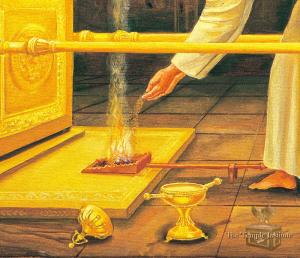
From his palms the Kohen Gadol places the incense onto the coals in the shovel, on the side of the shovel away from where he is standing, so that he will not be burned as the flames ignite. He stands there and waits momentarily, until the entire chamber is filled with smoke.
The Yom Kippur incense offering completed, he then exits the Holy of Holies with extreme reverence – backwards, entering through the two curtains back into the Sanctuary without once having turned his back on the holy place.
Offering a Prayer with Uplifted Hands
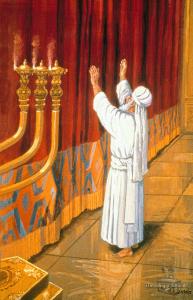
Standing alone in the Sanctuary, the Kohen Gadol has successfully entered and exited the holiest place on earth – the center of creation and of G-d’s glory. He has made atonement for his people in the manner which G-d has prescribed for this holy day. Thus it would be most natural for him to reflect upon this rarefied moment of Divine communion by offering his own heartfelt prayer.
Though not mentioned, the image selected to show the Kohen Gadol‘s prayer depicts him before the curtain praying with uplifted hands.
Second Offering in the Holy of Holies
In the next stage of the Yom Kippur service, after the Kohen Gadol concluded the incense service, uttered his prayer and exits the Sanctuary, he returns to the kohen who is waiting for him outside the entrance. This kohen has been waiting here since the bullock was slaughtered, holding the mizrak and moving it about so that its contents will not harden.
The Kohen Gadol now receives this vessel from his colleague and returns back into the Holy of Holies a second time, exactly as he did previously. Walking through the two curtains and carrying the vessel holding the blood of his offering, he comes back to spot “between the poles” where he placed the incense on the coals atop the foundation stone.
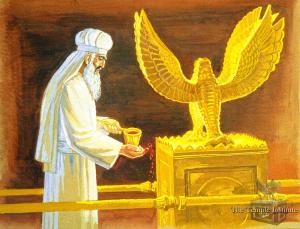
There, he sprinkles in the air with his finger from the contents of the mizrak, towards the spot of the ark-cover. This is as specified by the verse (Lev. 16:14), “He shall take some of the bullock’s blood, and with his forefinger he shall sprinkle it above the east side of the ark cover. He shall then sprinkle with his forefinger seven times directly towards the ark cover.”
Afterwards he leaves the Holy of Holies (in the same manner we have discussed above), and places the vessel on a golden stand within the Sanctuary.


